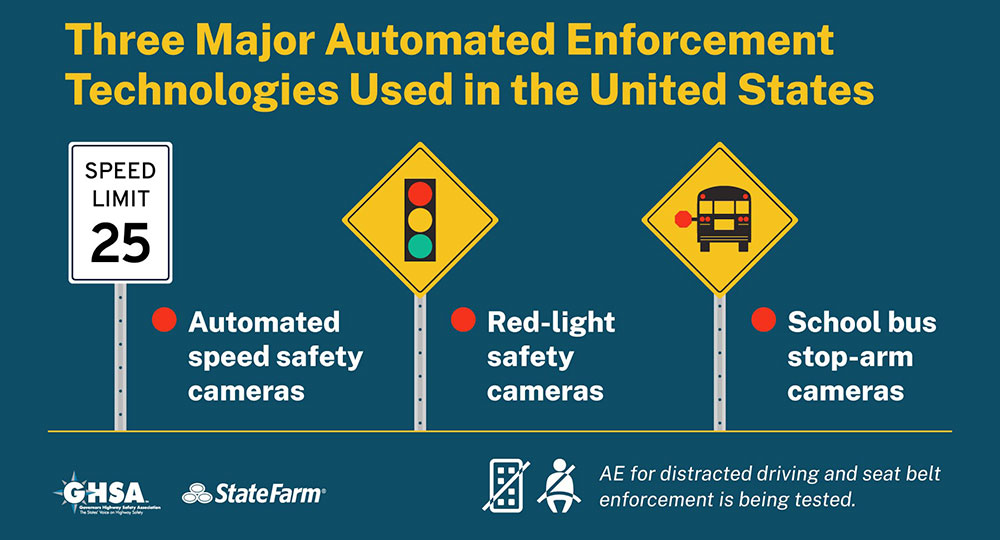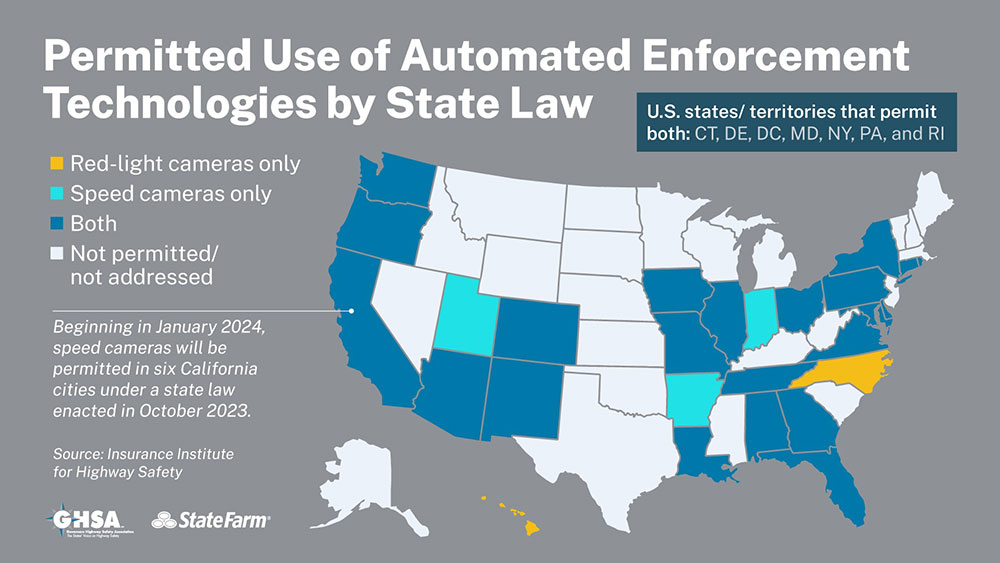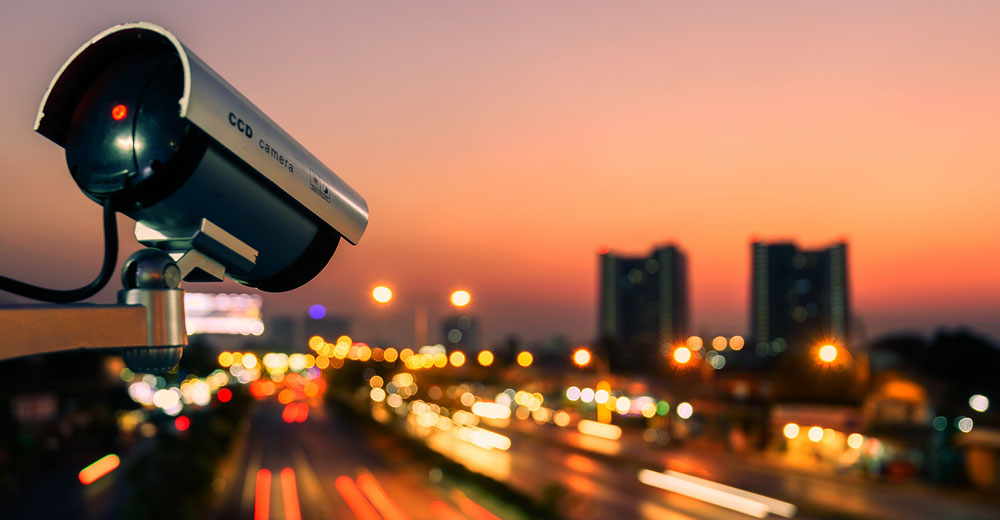A highway safety group released a report Tuesday urging communities to deploy automated enforcement programs using traffic cameras.
The report by the Governors Highway Safety Association (GHSA) maintained that such programs are needed to address the ever-increasing number of roadway fatalities. Over the last decade, traffic deaths have increased 30%, to 42,795 in 2022 from 32,893 in 2013, it noted.
“We’re losing far too many of our friends and loved ones to preventable traffic crashes,” GHSA Chief Executive Officer Jonathan Adkins said in a statement.
“Safety cameras can help change that,” he continued. “The data and research clearly show that automated enforcement reduces the dangerous driving behaviors that needlessly kill people every day.”
The report, which was prepared with funding from insurer State Farm, explained that technology has been used to improve safety in the past, such as the use of airbags to reduce the severity of injuries in crashes, alcohol breathalyzers to help police detect and remove impaired drivers from the road and radar speed displays to give drivers instant feedback on how fast they are going, encouraging them to slow down.
Now, a new generation of technological advances is available to safety and enforcement professionals, the report continued. GHSA believes the expanded use of automated enforcement is essential for roadways.
Funding Gate Opened
“The fatality numbers are higher than they’ve been in many, many years,” GHSA Senior Director of External Engagement Pam Fischer told TechNewsWorld.
“We need to use as many resources as we possibly can to address the problem,” she continued. “Things like speeding, red-light running, and aggressive driving are all preventable, and we know this technology is a viable solution to address these problems.”

For many years, funding traffic cam systems could be challenging for municipalities because they couldn’t use federal highway money to do it. It was prohibited by law.
That changed with President Biden’s “Build America Buy America Act,” which lifted the ban and allowed up to 10% of the $15.6 billion allocated for highway safety programs over five years to be used for specific non-infrastructure programs, including purchasing, operating, or maintaining automated traffic enforcement systems in work zones or school zones.
“The highway safety offices now have the ability, through federal funding, to support these programs,” Fischer said. “They can help communities leverage this technology if it makes sense.”
Behavior Changer
Fischer added that with traffic fatalities increasing, it became apparent that the states needed to leverage traffic cam technology.
“There was a recognition among elected officials in Washington that we needed to start looking at things differently and recognize there’s a plethora of research done by the Institute for Highway Safety and other groups showing that this technology does help change behavior,” she said.
“Many people get a traffic ticket through an automated enforcement program, and they don’t get another one because they learned their lesson,” she explained. “It’s a very effective countermeasure.”
Automated enforcement programs can be controversial, raising issues about privacy and targeting disadvantaged populations.
“Any camera poses a privacy concern,” said Rob Enderle, president and principal analyst with the Enderle Group, an advisory services firm in Bend, Ore.
“The benefit — which is tied to lower cost for enforcement and potentially safer roads — has to exceed these concerns,” he told TechNewsWorld.
‘Not About Invading Privacy’
The report pointed out that, according to the legal community, automated enforcement does not violate a citizen’s legal right to privacy.
It added that it is vital to the success of any program to address this issue upfront and make very clear what the public is gaining in return in terms of public safety.
“This technology is not about invading your privacy,” Fischer said. “It’s about making sure everyone using the roadway system, driving vehicles, is doing so in a manner that’s safe, not only for ourselves but for everybody else.”
“Driving is a public activity, and we need to hold ourselves to the standards established by our traffic safety laws so we are not hurting other people,” she added. “If we all did that, then we wouldn’t need this technology.”

Targeting low-income populations has been a criticism leveled at traffic cam systems and has forced some cities to scrap their systems.
ProPublica reported that Rochester, N.Y. eliminated its red-light camera program in 2016, in part because motorists from low-income neighborhoods received the most tickets and the financial harm outweighed any safety benefits, while Miami ended its program in 2017 amid complaints from low-income residents who felt unfairly burdened by the fines.
More or Less Equality?
“Reducing crashes and making city streets safer is a worthwhile goal, but there are other ways to do it that don’t sacrifice privacy or risk punishing disadvantaged communities that are already subject to more policing and have seen their roads and other infrastructure neglected,” maintained Josh Richman, media relations director for the Electronic Frontier Foundation, an international non-profit digital rights group based in San Francisco.
“Cities and states could instead implement traffic-calming road modifications to get drivers to slow down,” he told TechNewsWorld. “If the goal is better safety, surveillance — which invades everyone’s privacy whether or not they’re obeying the rules of the road — is not necessarily the right fix.”
However, the report noted that traffic cams have the potential to create a more equitable system.
Automated enforcement allows jurisdictions to use camera technology to enforce traffic laws as a racially neutral, unbiased, and contact-free alternative while simultaneously regaining trust within communities, the report maintained.
“Does it matter whether you are a poor person or a rich person if you are speeding?” asked Wes Guckert, president and CEO of The Traffic Group, a traffic engineering and transportation planning specialty firm in Baltimore.
“Either way, you are creating opportunities for accidents and potentially hurting someone else,” Guckert told TechNewsWorld. “It doesn’t matter whether you’re rich or poor; if you are driving in an unsafe manner, you should be ticketed.”
Effectiveness and Equity
The report stated that the unprecedented rise in traffic fatalities requires new roadway safety approaches.
Police officers cannot be present on every roadway or address all traffic violations that occur, it continued. Automated enforcement affords states the ability to augment traditional enforcement efforts with proven technology that can prevent severe injuries and save lives.
In addition, it added, AE can help advance equitable enforcement and be integrated into a state’s meaningful community engagement efforts.























































